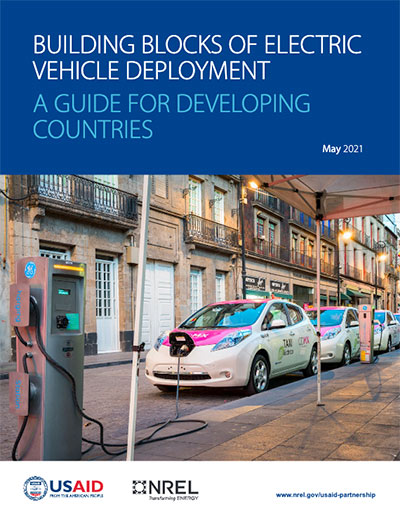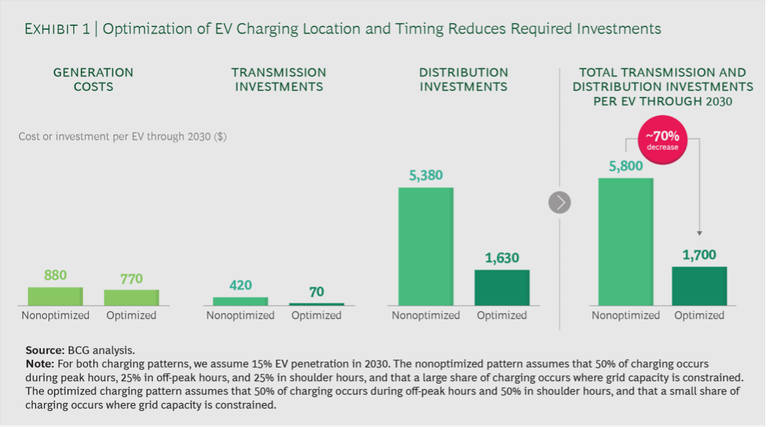Grid Planning and Management
Summary for Decision Makers
New EV loads on the electric grid present both challenges and opportunities
EVs represent a large potential source of load growth for electric utilities, as the energy needed for transportation shifts from petroleum to electricity. At the same time, these new EV loads may create costly challenges to ensuring that the grid can reliably support every customer. Utilities are responsible for maintaining the grid, and so may need to implement new planning practices and dedicated EV programs to successfully meet the demands of increased EV deployment. Hiring a dedicated EV team, supporting managed charging programs, creating customer-friendly products and services to ensure right-sized EVSE is installed successfully in desired locations, and matching utility resource plans to EV deployment projections are all practices that lead to lower grid upgrade costs for utilities.
Planning For EVSE
Long-term preparation and planning by utilities can ensure timely and cost-effective deployment of EVSE networks
Widespread adoption of EVs will require a proportional buildout of EVSE to allow for convenient and accessible refueling options for EV owners. Depending on the type and volume of EV and EVSE deployed, investment in grid infrastructure may be required to accommodate the additional charging load. Distribution system upgrades are the most common requirement, but transmission systems are sometimes impacted as well. These grid upgrades can take months or years to complete, depending on the scale of improvement. Therefore, a key pathway for utilities to support EV deployment is through dedicated planning for EVSE projects.
Utility staff positions dedicated to EVs are often needed to help forecast EV demand, design specialized EV tariffs, and incorporate EV-related investments into utility resource planning. because high-power charging units often require much more intensive grid upgrades, communication with EVSE developers is crucial for utilities to avoid outsized expenditures. Adding electrical infrastructure that is sufficient for high-power DCFC systems may be a costly overbuild if it only ends up servicing Level 2 EVSE, for example. However, installing the capacity to handle expected load growth and future EV technologies may ultimately save money. New build infrastructure is far less expensive than retrofitting, so understanding the future charging needs of an EVSE installation is crucial for long-term project economics.
For customers pursuing large projects, such as an original equipment manufacturer supporting EVSE deployment or a fleet of vehicles requiring major EVSE-related upgrades, technical support staff may be the optimal choice to streamline the permitting and procurement processes. For small installations or residential customers, simply having access to a brochure or online process guide can allow EVSE projects to proceed smoothly. For all customers, it is important for the utility to be transparent about the time required for grid upgrades.
Business Models
Utilities should engage with EVSE projects of all types and ownership models
Broadly considered, there are two types of EVSE deployment: utility-led charging infrastructure programs and third-party charging infrastructure interconnection. In places where the utility has limited resources, a higher percentage of EVSE projects will be led by third parties, especially the private sector. In each case, the utility has a role in guiding projects to both enable EV deployment and minimize grid upgrade costs.
If the utility itself decides to fully support EVSE, it can significantly reduce common barriers to third-party EVSE deployment, such as uncertainty surrounding utility processes, access to financing, cost barriers, and interconnection timelines. Complete utility ownership, including funding, construction, and maintenance can thus streamline EVSE deployment, but there are often barriers such as land tenure, interest in maintaining charging stations, and justifying EVSE investments to regulators.
In cases where third parties lead infrastructure programs, utilities still have an interest in assisting the process, as poor execution of an EVSE installation could lead to misallocated utility resources. Options include offering rebates to customers for all or part of the necessary equipment and construction and designing and installing “make-ready” infrastructure.
Managed Charging
Altering the timing and power level of charging can reduce system costs and improve grid stability
EVs comprise a load that can sometimes create technical challenges for utilities if unmanaged. At the same time, charging load is potentially flexible in ways that can aid grid management and increase utilization of existing assets to reduce system costs. Completely unmanaged EV refueling results in more extreme charging patterns and loads. Sometimes this demand can helpfully match with periods of excess generation, but it also may necessitate large and widespread upgrades to grid infrastructure. By spreading the EV charging over time, so that localized and systemwide demand peaks are avoided and the timing of EV charging coincides with times of abundant and low-cost electricity generation, utilities can reduce the need for generation, transmission, and especially distribution grid upgrades.
The figure below, developed by Sahoo, Mistry, and Baker (2019), shows the potential difference in grid upgrade costs on a per-EV basis depending on whether charging load is unaltered (“nonoptimized”) or optimized to match grid capabilities. This type of optimization is a central goal of managed charging, which seeks to capture these savings while also ensuring that EV refueling occurs in a manner that is satisfactory to the customer. However, the benefits of managed charging are only proportional to the utility’s EV load—without a sufficient level of EV deployment, the costs of managed charging may outweigh the benefits.
There are two broad categories of managed charging: passive and active. Passive managed charging provides incentives for time-shifted charging, but ultimately leaves decisions to customers. Active managed charging involves the physical control of electron flow, whether at the EV itself, the charging device (EVSE), or by controlling the circuits that connect to the EVSE. Passive strategies cannot provide precise demand response in the same way that active methods can, but active methods will require additional technological upgrades and more frequent monitoring by the utility.
Vehicle-to-Grid (V2G)
Managed charging is a set of strategies to modulate the one-directional flow of electricity to EVs. V2G is a concept of complete vehicle-grid integration that additionally includes the flow of energy from plugged-in EVs back to the grid to provide a range of services. In this balancing act, fully charged EVs could help meet the demands of other EVs that need refueling. Major obstacles to V2G include expenses for current inversion and control, additional engineering requirements for interconnection, and, most importantly, battery warranties. V2G will inevitably result in additional charge/discharge cycles for vehicle batteries, leading to issues for vehicle manufacturers in terms of warranty adjustment and issues surrounding fair compensation for the EV’s contributions to the grid.
The challenges associated with full, widespread V2G raise the question of the additional benefits provided by its bidirectional energy flows. In terms of demand response and grid balancing, experts estimate that managed charging alone (vehicle-grid integration) can provide substantial benefits with currently available technology.
Additional Resources
A Comprehensive Guide to Electric Vehicle Managed Charging (SEPA 2019)
Preparing for an Electric Vehicle Future: How Utilities can Succeed (SEPA 2019)



